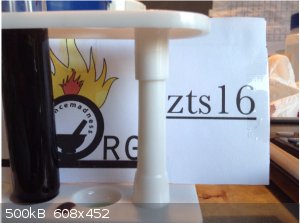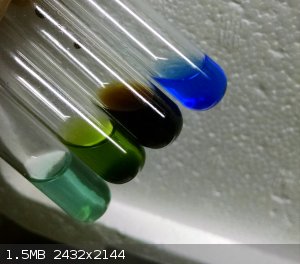Fidelmios
Hazard to Others
  
Posts: 104
Registered: 28-4-2016
Location: Witty Chemistry Joke
Member Is Offline
Mood: No Mood
|
|
Want to make some pretty copper solutions for a demonstration
Brief hiatus but I'm back!
So as the title says I intend to make a display of some copper aolutions. My goal is to make a rainbow of 'copper'. Preferably solutions.
So far I've gotten blue (obviously), green and yellow(both chlorinated copper), and violet via the tetraamine.
Now I could make Chevrouls salt, and get a better green color, as well as a red color, from the salt itself. If I wanted to go liquids for a display
what would I need to make the red and orange sides of the spectrum? I'd rather go all liquids rather than solids, for the dramatic effect. Maybe
suspended oxides? I'm not sure but I would love your take on the matter because I'm stumpted.
My summer challenge was to make a rainbow of copper, with my starting chemical being Ole blue, copper sulfate. So I'd they fit within the confines of
this challenge that would be wonderdul!
Also I've got a 20lb bag of the stuff, and it's pretty impure (thanks seed ranch). So short of a massive recrystalization I would love to know what I
should do with it.
|
|
|
j_sum1
Administrator
       
Posts: 6229
Registered: 4-10-2014
Location: Unmoved
Member Is Offline
Mood: Organised
|
|
Cu(I) gives the oranges and reds that you might want. I can't say I have played much with Cu(I). Reduction of sugars (aka Benedict's solution) might
be the simplest way in.
For a purple, add copper sulfate solution to a solution of sodium dichloroisocyanurate in stoichiometric ratio. Beautiful vivid precipitate forms
that filters easily. Lots of fun.
|
|
|
TheMrbunGee
Hazard to Others
  
Posts: 364
Registered: 13-7-2016
Location: EU
Member Is Offline
Mood: Phosphorising
|
|
You can put copper acetate in between blue and green!
Not sure about soluble red/orange compounds... Suspensions will eventually settle down..
|
|
|
MeshPL
Hazard to Others
  
Posts: 329
Registered: 20-4-2015
Location: Universe
Member Is Offline
Mood: No Mood
|
|
If you want to make copper (I) oxide easily, try electrolysis of brine using copper electrodes. Works great.
An addition of nitrite to a copper solution also produces green solution.
Solutions containing bromides and Cu(II) had some reddish brown colours, but for the best effect the solution should be chloride free, addition of the
chloride produces different colour.
If you want to make some kind of rainbows, chromium might be a good idea, as blue (Cr2(SO4)3), green (CrCl3), anything between red and yellow
(chromates in different pH), and even some violets (I think reducing chromates with oxalate in acidic enviroment produced purple solutions and
reacting chromium (III) withbammonia did that too) are obtainable. And there is also Cr(II) which is blue, but hard to make.
|
|
|
j_sum1
Administrator
       
Posts: 6229
Registered: 4-10-2014
Location: Unmoved
Member Is Offline
Mood: Organised
|
|
Quote: Originally posted by MeshPL  |
Solutions containing bromides and Cu(II) had some reddish brown colours, but for the best effect the solution should be chloride free, addition of the
chloride produces different colour. |
Good point. Cu(II) complexed with Br- gives some nice colours. High concentrations of bromide are needed. You might investigate some other
complexing agents too.
|
|
|
Texium
Administrator
       
Posts: 4516
Registered: 11-1-2014
Location: Salt Lake City
Member Is Offline
Mood: PhD candidate!
|
|
Yes, the bromo complex is a dark red color when concentrated, but it's actually so dark that a beaker or even a test tube full of it just looks black.
When dilute it's yellow. Here's a picture of it from my Copper Carnival entry:

As you can see, it's extremely dark, but the red color is visible in the drop that I placed to the side of the test tube.
|
|
|
Fidelmios
Hazard to Others
  
Posts: 104
Registered: 28-4-2016
Location: Witty Chemistry Joke
Member Is Offline
Mood: No Mood
|
|
So copper 1 oxide, I'll just make it from copper carbonate decomposition. The cooperating acetate will probably be put in as the violet color.
|
|
|
MrHomeScientist
International Hazard
    
Posts: 1806
Registered: 24-10-2010
Location: Flerovium
Member Is Offline
Mood: No Mood
|
|
Woelen's site has some great copper chemistry with lots of unusual colors - this page has some very nice reds and purples. Search his site for other copper experiments; I'm sure there's just about every color you could ask
for.
|
|
|
woelen
Super Administrator
        
Posts: 7977
Registered: 20-8-2005
Location: Netherlands
Member Is Offline
Mood: interested
|
|
Just to name a few:
Copper(III) periodato complex: deep red
Copper(I) oxide: bright yellow or brick red, depending on how it is made
Cesium tetrachlorocuprate((II): bright red/orange
Tetrabromocuprate(II) complex: very dark purple
If you only want solutions and no suspensions:
Tetrabromocuprate(II) complex, very dilute: purple/red
Copper(III) periodato complex: deep red (like red wine)
Copper(II) chloride with table salt: green like grass
Copper(II) with excess ammonia: deep royal blue
Copper(II) plain aqueous: sky blue
Copper(II) sulfate in strong/conc. HCl: yellow/brown
|
|
|
mayko
International Hazard
    
Posts: 1218
Registered: 17-1-2013
Location: Carrboro, NC
Member Is Offline
Mood: anomalous (Euclid class)
|
|
Copper (II) bromide shows a variety of colors depending on concentration and complexing ions, as well as solvatochromism. Ethanol solutions in
particular appear a brown which you might be able to pass off as red.
CuBr2, dissolved in (bottom to top) water, acetone, ethanol, ammonia:

al-khemie is not a terrorist organization
"Chemicals, chemicals... I need chemicals!" - George Hayduke
"Wubbalubba dub-dub!" - Rick Sanchez
|
|
|